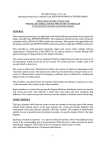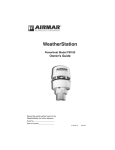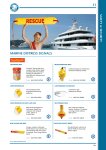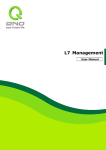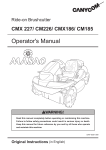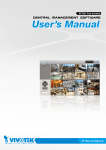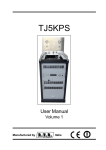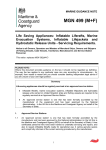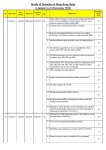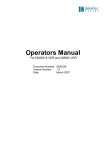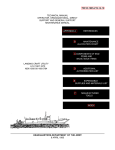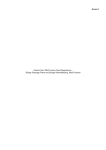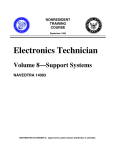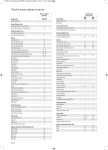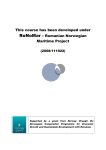Download SEQ Report - Indian Register of Shipping
Transcript
Report of Safety Equipment Survey
Type of Survey: Initial/ Annual/ Periodical/ Renewal/ Change of Flag
for Cargo Ships (including Oil, Chemical Tankers & Gas Carriers)/ Passenger Ships*
Name of ship: ………………………………..
I. R. No.: ……………………….
Port of Survey: ………………………………
Report No.: …………………….
Use “Y” for yes /satisfactory, “NO” for no, “N” for not satisfactory/ see recommendation in continuation sheet and “–”
for not applicable.
NOTES:
1
Requirements for a Periodical Survey are the same as that of a Renewal Survey except examination of the
deck water seal internally and checking the condition of non-return valve on board oil tankers.
2
Each lifeboat is required to be launched and manoeuvred at least once every 3 months.
3
Falls used in launching appliances/ accommodation ladders/ gangways shall be inspected periodically with
special regard for areas passing through sheaves, and renewed when necessary due to deterioration of the falls
or at intervals of not more than 5 years, whichever is earlier.
4
For Sr. No 2.14, 2.15, and 2.16: Examination and operational tests to be done by competent person approved
by the Administration in presence of surveyor. Records and approval of competent person along with its
validity to be sighted. Weight of persons 82.5 kg except for passenger ships lifeboats (75 kg) built after 1 July
2010.
5
Please refer relevant Flag State Instructions for maintenance, inspection and pressure testing of LSA and
FFA equipments.
6
Ships may be fitted with equipment over and above her requirement. Same to be maintained and included in
report
1. GENERAL
1.1
Had any changes been made or new equipment been installed which would effect the validity of the
Cargo Ship Safety Equipment Certificate?
...
1.2
Copy of the documentation where alternative design and arrangements have been approved by the
administration is available on board including re-evaluation due to change of conditions.
...
1.3
All instructions and/or notices including the Emergency Station Muster List and Training Manual
were posted in the appropriate language as required and to the Master’s satisfaction.
…
1.4
All other Statutory Certificates and the Class Certificate were valid at the time of survey
…
1.5
Was there a report of any fire necessitating the operation of the fixed fire extinguishing systems or
the portable fire extinguishers, since the last Safety Equipment Survey? (If “YES” give details in
section 35)
...
1.6
LSA items are marked with the name of ship, call sign, port of registry etc., as required
...
1.7
Confirmation that LSA which are required to be float free, have been installed in location not
obstructed by other structure/s in the vicinity and it can float free in case the vessel sinks.
...
1.8
For a passenger ship, confirmation that a list of all limitations on the operation of the ship including
exemptions from any of these regulations, restrictions in operating areas, weather restrictions, sea
state restrictions, restrictions in permissible loads, trim, speed and any other limitations, whether
imposed by the Administration or established during the design or the building stages, has been
compiled, documented and readily available to the Master. The list has been kept up to date.
...
___________________________________________________________________________________
Form No.: Rpt.SEQ (Rev.15)
Page 1 of 17
*Delete as appropriate
2. DOCUMENTATION
2.1
Fire control Plans (including duplicate set permanently stored in a prominently marked weathertight
enclosure outside the deck house) properly posted
…
2.2
Muster List
…
2.3
Adequate and up-to-date nautical charts/ ECDIS, sailing directions, lists of lights, Notices to
Mariners, tide tables and all other nautical publications necessary for the intended voyage
…
2.4
International Code of Signals and IAMSAR Manual Volume III.
…
2.5.1
Practice Musters and Drills. (It is also confirmed that arrangement for mustering crew/passengers are
in order and the person in charge of survival craft and in the case of lifeboats the second in-command
have a list of the survival craft crew)
…
FCP Plan Approved by
on
LSA Plan Approved by
on
2.5.2
Confirmed that new crew member with assigned emergency duties had been familiarised with these
duties before the voyage began.
…
2.5.3
Confirmed that where the ship was engaged on a voyage where passengers were scheduled to be on
board for more than 24 h, musters of the newly embarked passengers had taken place prior to
departure.
…
2.5.4
Confirmed that whenever new passengers had embarked, a passenger safety briefing had been given
immediately before departure.
…
2.6.1
Date of last fire and boat drills (which should include inspection of those items of operating equipment
included in the check list as contained in the instructions, or on-board maintenance) (Every crew member
shall participate in at least one abandon ship drill and one fire drill every month. The drills of the crew shall
take place within 24 h of the ship leaving a port if more than 25% of the crew have not participated in
abandon ship and fire drills on board that particular ship in the previous month. When a ship enters service
for the first time, after modification of a major character or when a new crew is engaged, these drills shall
be held before sailing.) Fire drill ………………………………… Boat drill …......................................
2.6.2
Date of visual inspection of survival craft, rescue boats/ work boat, launching appliances, testing of lifeboat
and rescue boats/ work boat engine, and testing of the general alarm system (Required weekly) …………
2.6.3
Date of last enclosed space entry and rescue drill carried out (required at least once every two months) (with
effect from 1 January 2015).......................................
2.6.4
Date of last emergency steering drill carried out (required at least once every three months) …......................
2.7
Log book entries as required by Chapter III and the Master aware of the intent of chapter II-2. “In
all new and existing ships fire extinguishing appliances shall be kept in good order and available for
immediate use at all times during the voyage”
…
2.8
Boats equipment examined at that time and found to be complete. (It is further confirmed that
monthly inspections of all survival craft and rescue boats/ work boat including engines and launching
appliances plus the general alarm system are being carried out and logged )
…
2.9.1
Dates when lifeboat falls renewed (See
Note 3 on Page 1)
BOAT
RENEWED
1
2
3
4
2.9.2
Date Rescue boat/ work boat falls last renewed ……………………………………
2.9.2.1
Date falls renewed for 2nd Rescue boat (required for passenger ships above 500 GT) …......…
___________________________________________________________________________________
Form No.: Rpt.SEQ (Rev.15)
Page 2 of 17
*Delete as appropriate
2.9.3
Dates when liferaft davit falls renewed
(See Note 3 on Page 1)
RAFT
DATE RENEWED
1
2
3
4
…
2.9.4
Record of periodical inspection of lifeboat falls maintained.
2.10.1
Last occasion davit launched lifeboats moved from stowed position/ turned out/ launched and manoeuvred
(See note 2)
Boat
Moved from stowed position
(Weekly) (Only for cargo ships)
Turned out (Monthly)
Launched and manoeuvred in water
(3 monthly)
1
2
3
4
2.10.2
Last occasion free fall lifeboat lowered/ launched and manoeuvred
Boat
Free fall launched/ lowered by secondary
means* and manoeuvred in water (3 monthly)
Free fall launched/ simulated launching carried
out* and boat manoeuvred in water (6 monthly)
1
2
2.11.1
Last occasion rescue boat was launched and manoeuvred. (Required monthly where practicable; but interval
not to exceed 3 months) ……………………………………………….
2.11.2
Date 2nd Rescue boat (required for passenger ships above 500 GT) was launched and manoeuvred
……………………………………..
2.12
Marine Evacuation System (if provided on ro-ro passenger ships/ passenger ships) last deployed
MES
Test deployment (at least 50% after installation
and remaining within 12 months)
Each every 6 years
1
2
2.13
Servicing of Inflatable Liferafts, Hydrostatic release unit, inflatable life jackets and marine evacuation
system:
2.13.1
Liferafts and HRU (Include in the table details of any liferaft stowed forward or aft)
Sr. no
Makers Name
& Serial
Number of
Liferaft
No. of
Persons
Date
Serviced
Date
Service
Due
Location
on board
Servicing
Agent
Date HRU
Serviced
HRU Expiry
/ Next
Servicing
Due
i
ii
iii
iv
v
___________________________________________________________________________________
Form No.: Rpt.SEQ (Rev.15)
Page 3 of 17
*Delete as appropriate
Liferafts for easy side to side transfer are less than 185 kg
...
2.13.2
Servicing of inflatable lifejackets carried out on …………………………………………………
2.13.3
Servicing of Marine Evacuation System carried out on ……………………/…………………….
Provide different dates if required.
2.14
Davit launched lifeboat/ liferaft*
Annual
5 yearly
2.14.1
Thorough examination of launching appliances, and dynamic test of the winch
brake at maximum lowering speed for davit launched lifeboats.
............
.............
............
.............
............
.............
............
.............
............
.............
............
.............
............
.............
............
.............
...........
...........
2.14.2
2.14.3
2.14.4
Thorough examination and operational test of on load release gear for davit
launched lifeboat.
Thorough examination of launching appliances, and dynamic test of the winch
brake at maximum lowering speed for davit launched liferafts
Thorough examination and operational test of automatic release hooks for davit
launched liferaft.
2.15
Free fall lifeboat:
2.15.1
Thorough examination and operational test of release system for free fall lifeboat
2.16
Dedicated Rescue boat:
2.16.1
Thorough examination of launching appliances, and dynamic test of the winch
brake at maximum lowering speed for dedicated rescue boats
...........
...........
2.16.2
Thorough examination and operational test of on load release gear for dedicated
rescue boat.
............
..........
2.16.3
Date of last service of inflated rescue boat …………………………………
2.16.4
Work boats (Indian ships on coast and having work boat in lieu of rescue boat)
Annual
5 yearly
2.16.5
Man Overboard drill and Operational test for Work boats and launching appliances
...........
..........
2.16.6
Load test of the work boat and launching appliances to Maximum Working Load
2.17
Hydraulic pressure testing of cylinders of lifeboat air support system, where provided …………………..
(Required every 5 years)
2.18.1
Compass Deviation Record Book being kept up-to-date.
…
2.18.2
Diagram of Radar installation shadow sector is displayed.
...
2.19
Instructions for on board maintenance of Life Saving appliances – easily understood and illustrated
wherever possible
…
2.20.1
Verification of compliance as per Safe Manning Document or equivalent issued by Administration
…
..........
(including STCW certificates of Crew, officers and with necessary endorsements)
2.20.2
Verification with respect to availability of sufficient number of trained persons for mustering and
manning the survival crafts including availability of sufficient crew member ( deck officers or
certificated persons) for operating the survival crafts and launching arrangements
…
2.21.1
Maintenance plan for fire fighting systems and appliances available on board
…
2.21.2
For ships carrying more than 36 passengers, maintenance plan for low-location lighting and public
address systems available on board
…
___________________________________________________________________________________
Form No.: Rpt.SEQ (Rev.15)
Page 4 of 17
*Delete as appropriate
2.21.3
For tankers, maintenance plan for inert gas system, deck foam system, fire safety arrangement in
cargo pump room and flammable gas detectors available on board
…
2.22
Fire safety operational booklets have been provided
…
2.23
Record of navigational activities
…
2.23.1
Record of daily reporting
…
2.24.1
SOLAS Training Manual (for L.S.A. & F. F. A.)
…
2.24.2
Where the ship is fitted with a marine evacuation system, on-board training aids in the use of the
system has been provided.
…
2.25
Procedures required for data retrieval from VDR / S-VDR included in the ship’s safety management
system.
…
2.26
On passenger ships: Decision support system for master on the navigation bridge
…
2.27
Operational and, where appropriate, maintenance manuals for all navigational equipment provided
...
2.28
Ship specific plans and procedures for recovery of persons from water available on board.
(Applicable to ships built on or after 1 July 2014 when they are put into operation, For existing ships
applicable from first periodical/ renewal survey carried out on or after 1 July 2014)
...
3. SAFETY OF NAVIGATION
3.1
Standard Magnetic Compass
...
3.1.1
Spare Magnetic Compass
…
3.2
Gyro Compass at main steering position
…
3.2.1
Gyro Compass heading repeaters
…
3.2.2
Gyro Compass bearing repeaters
…
3.3
Heading or Track Control System
…
3.4
Pelorus or compass bearing device
…
3.5
Transmitting Heading Device
…
3.6
Means of correcting heading and bearings
…
3.7
Electronic Chart Display and information system (ECDIS)/Nautical charts*
Performance Standard of ECDIS: MSC.232(82)/ A.871(19) as amended***
…
**
ECDIS installed on or after 1 January 2009 to comply with MSC.232(82), prior to date may comply with A.871(19) as
amended
3.7.1
Back up arrangements for ECDIS: 2nd ECDIS/ Nautical charts*
…
3.8
Nautical publications
…
3.9
Receiver for a Global Navigation Satellite System / a Terrestrial Radio Navigation System
…
3.10.1
Radar 9GHZ (3 cm)
…
3.10.2
Second Radar {3 cm (9 GHz)/ 10 cm(3 GHz)*}
…
3.11
Automatic Radar Plotting Aids (ARPA) for (3.10.1/ 3.10.2/ both*)
…
3.12.1
Auto Tracking Aid (ATA)
…
3.12.2
Second automatic tracking aid
…
3.13
Electronic Plotting Aid (EPA)
…
___________________________________________________________________________________
Form No.: Rpt.SEQ (Rev.15)
Page 5 of 17
*Delete as appropriate
3.14
Automatic Identification System (AIS); Annual test carried out on ............
…
3.14.1
Long Range Identification & Tracking System (Valid Conformance Test report available)
…
3.15.1
Voyage Data Recorder (VDR) Annual performance Test carried out on ..................
…
3.15.1.1
If float free type or arrangements provided (Mandatory for VDR type approved as per MSC.333(90),
this provision is also mandatory for some flag – refer flag state instruction)
…
3.15.2
Simplified voyage data recorder (SVDR) Annual Performance Test carried out on ..................
…
3.15.2.1
If float free type or arrangements provided (This provision is mandatory for some flag – refer flag
state instruction)
…
3.16.1
Speed and Distance measuring device(through water)
…
3.16.2
Speed and Distance measuring device (Over ground in fwd and athwart ship direction)
…
3.17
Echo Sounding Device
…
3.18
Rudder Angle Indicator, RPM Indicator and Pitch Indicator
…
3.19
Rate of turn indicator
…
3.20
Sound reception System for totally enclosed navigation bridge
…
3.21
Telephone to Emergency Steering Position
…
3.22
Bridge Navigation Watch Alarm System (BNWAS) Performance Standard: MSC.128(75) ††
…
††
For BNWAS installed after 1 July 2003, However BNWAS installed prior to 1 July 2011 may be exempted by administration
4. SIGNALLING APPARATUS:
The following found in satisfactory condition:
4.1
Daylight signaling lamp and source of power
…
4.2
Forecastle bell
…
4.3
Gong
…
4.4
Ship’s Whistle
…
4.5
Three black ball shapes
…
4.6
One black diamond shape
…
4.7
Cylindrical shape
…
4.8
Radar reflectors (applicable for vessels with GT<150)
…
5. NAVIGATION LIGHTS
5.1
LSS Plan (Indian flagged vessels) Approved by
on
5.2
Sidelight inboard screens painted matt black
…
5.3
Navigation lights in good condition and operating satisfactorily
…
5.4
Navigation light failure warning device: Visual/Audible on bridges operating efficiently
…
___________________________________________________________________________________
Form No.: Rpt.SEQ (Rev.15)
Page 6 of 17
*Delete as appropriate
6. BRIDGE DISTRESS SIGNALS
Indicate expiry date (E) or manufacture date (M) of the following
E/M
6.1
12 red parachute signals
6.2
Line throwing rockets, and
6.3
Igniter cartridges (if applicable)
6.4
Line throwing rockets and ship’s distress flares in good condition
DATE
…
7. SURVIVAL CRAFT, RESCUE BOAT AND ASSOCIATED LAUNCHING, AND RECOVERY APPLIANCES
7.1
Lifeboats turned out and lowered to Embarkation Deck, at time of Survey, OR
(circle number as appropriate). Recovery of lifeboat verified satisfactorily.
1
2
3
4
7.2
Life boats turned out, lowered and maneuvered in water (Circle number as
appropriate). Recovery of lifeboat verified satisfactorily.
1
2
3
4
7.3
Each motor lifeboat engine readily started and operated satisfactorily, ahead and astern
…
7.4
Lifeboats capable of being launched, where necessary utilizing painter, with ship making headway
at speeds up to 5 knots in calm water (required for new installations/modification)
…
7.5
Each lifeboat self contained air support system generally examined and found satisfactory
…
7.6
Each lifeboat water spray system generally examined and found efficient
…
7.7
Each lifeboat water spray system/self-contained air support system satisfactorily tested
…
7.8
Each motor lifeboat provided with sufficient fuel for 24 hours continuous operation
…
7.9
Air cases removed, found or placed in good condition, replaced and secured, OR
…
7.10
Built-in buoyancy found in good condition as far as seen
…
7.11
Each lifeboat found in good condition and fully equipped
…
7.12
All sheaves, blocks, falls, lifting hooks, hook foundations and securing arrangements, release
arrangements and all moving parts found free and well lubricated or made good at time of survey
…
7.13
Freefall lifeboats: Launch track, release and recovery arrangements in satisfactory condition
…
7.14
All survival craft launching and recovery appliances found satisfactory when examined as far as
practicable‡‡
…
‡‡
Survival craft/ rescue boat davit’s SWL is not less than boat’s weight including equipment and personnel.
Check specially for life rafts replaced by life rafts of 82.5 kg/ person specification
…
7.15
Each lifeboat fitted with retro-reflective material
7.16
For
Self
Contained
Air
System
in
totally
enclosed
The provision of refilling air bottles if the air pressure of bottle drops by 20%
boats:
…
7.17
In case of Fire Protected Life Boats, the arrangements for flushing the water spray fire-protection
system with fresh water and allowing complete drainage
…
7.18
RESCUE BOAT (DEDICATED RESCUE BOAT * OR PORT*/ STBD* LIFE BOAT*)
7.18.1
Rescue boat examined, found in good condition and fully equipped
…
7.18.2
Launching and recovery appliance found satisfactory when examined as far as practicable
…
7.18.3
Release hook, falls and associated moving parts (blocks, sheaves, etc.) were found free and well
lubricated or made good at time of survey.
…
life
___________________________________________________________________________________
Form No.: Rpt.SEQ (Rev.15)
Page 7 of 17
*Delete as appropriate
7.18.4
The rescue boat was fitted with retro reflective material
…
7.18.5
Launching and recovery appliance test including overload test carried out to establish lowering and
recovery speed and to establish lowering and recovery possible at lightest sea-going draught.
…
7.18.6
Rescue boat engine readily started and operated satisfactorily, ahead and astern
…
7.18.7
Rescue boat lowered and recovery demonstrated while underway at 5knots. (required for new
installations/modification)
…
8. LIFEBOAT DISTRESS SIGNALS
Indicate expiry date (E) or manufacture date (M) of the following
E/M
BOAT 1
E/M
8.1
Two orange smoke signals
8.2
Four parachute signals
8.3
Six red hand-held flares
8.4
Lifeboat distress flares found in satisfactory condition
BOAT 2
E/M
BOAT 3
E/M
BOAT 4
…
9. SURVIVAL CRAFT LAUNCHING AND EMBARKATION ARRANGMENTS
9.1
Emergency power, lighting of muster and embarkation stations, alleyways, stairways and exits
giving access to the muster and embarkation stations; onboard communication and alarm operating
satisfactorily
…
9.2
Means of preventing discharge of water into boats found satisfactory
…
9.3
Illumination of stowage and launching positions found in working order
…
9.4
Lifelines on davit spans and bowsing tackles were found or placed in good condition (if applicable)
…
9.5
Embarkation ladders found or placed in good condition
…
9.6
Abandon ship audible signals operating satisfactorily
…
9.7
Operative test of all emergency power supplies, emergency lighting and general alarm systems
satisfactorily carried out
…
9.8
All embarkation arrangements and launching gear found to be satisfactory when examined as far as
practicable
…
9.9
IMO recommended symbols as required posted throughout the vessel
…
9.10
Lifeboat launching instructions posted
…
10. LIFE RAFTS
10.1
Life raft stowage will facilitate proper release including float free facility where required
…
10.2
Launching instructions posted
…
10.3
The embarkation arrangements of inflatable liferafts and, where provided, the launching
arrangements of davit launched liferafts found satisfactory.
…
11. RIGID LIFERAFTS
11.1
Each liferaft examined, found in a good condition, stowed to facilitate rapid launching and fitted
with retro reflective material
…
11.2
Raft and equipment complete and in good condition and raft with retro reflective material
…
___________________________________________________________________________________
Form No.: Rpt.SEQ (Rev.15)
Page 8 of 17
*Delete as appropriate
Indicate expiry date (E) or manufacture date (M)
E/M
11.3
Two orange smoke signals
11.4
Four parachute signals
11.5
Six red hand-held flares
R/L/RAFT. 1
E/M
R/L/RAFT 2
E/M
R/L/RAFT.3
12. STOWAGE OF SURVIVAL CRAFT AND RESCUE BOATS
12.1
Provision, disposition including stowage of Survival craft and rescue boat satisfactory and do not
interfere with operation of other survival crafts and rescue boats.
…
12.2
Survival crafts are fully equipped and in a state of continuous readiness
…
13. LIFEJACKETS
13.1
Complete number of approved lifejackets, as shown on Record of Equipments for SEQ Certificate
each with whistle and light
…
13.2
Each lifejacket found in good condition,
…
13.3
Lifejackets stowed in accessible and clearly marked places
…
13.4
Each lifejacket fitted with retro reflective material
…
13.5
Life Jacket Lights as per LSA Code Chapter II/2.2.3 (Manual switch provided if of flashing type)
…
13.6
Validity of life jacket lights. ……………………………………
13.7
For ships constructed before 1 July 2010, adequate number of lifejackets provided to fit persons
weighing up to 140 kgs and chest girth up to 1750 mm/ suitable accessories provided to lifejackets
which do not fit to persons weighing up to 140 kgs and chest girth up to 1750 mm.*
…
13.8
For passenger ships on voyages less than 24h, number of infant lifejackets provided equals to at
least 2.5% of the number of passengers on board and as per LSA plan
…
13.9
For passenger ships on voyages 24h or greater, number of infant lifejackets provided for each infant
on board
…
14. LIFEBUOYS, IMMERSION SUITS/ANTI-EXPOSURE SUITS AND THERMAL PROTECTIVE AIDS
14.1
Lifebuoys:
…
14.1.1
Complete in number as shown on Record of Equipments for SEQ Certificate and in good condition
…
14.1.2
Of highly visible colour, fitted with brackets and readily accessible
…
14.1.3
Marked in block letters with name and port of registry of ship
…
14.1.4
Fitted with lines, lights or light and smoke as on Record of Equipment for SEQ Certificates
…
14.1.5
Capable of being rapidly cast loose
…
14.1.6
Fitted with retro reflective material
…
14.1.7
MOB marker expiry date: 1 …………………………………. 2 ………………………………..
14.2
Immersion suits/Anti-exposure suits and thermal protective aids complete as on Record of
Equipment for SEQ Certificate and in good condition, including that, stowed in survival craft as
equipment.
___________________________________________________________________________________
Form No.: Rpt.SEQ (Rev.15)
Page 9 of 17
*Delete as appropriate
…
14.2.1
Immersion suits designed to be worn in conjunction with a lifejacket are suitably marked to indicate
that it must be worn in conjunction with a compatible lifejacket.
…
14.2.2
Monthly Inspection and testing of Immersion suits carried out
…
14.2.3
All Immersion suits/ anti exposure suits seams tested every 3 years (more frequently after 10 years).
…
Last testing done ……………………………………………………..
15. PILOT TRANSFER ARRANGEMENTS
15.1
Side ropes, man ropes and steps of pilot ladder in good condition; Certificate available on board for
pilot ladders supplied on or after 1 July 2012
…
15.2
The condition and illumination of the ladder(s) and boarding position in good order
…
15.3
A heaving line and one of the lifebuoys with self-igniting light readily available
…
15.4
Pilot ladder(s) and accommodation ladder(s) found to be in good condition
…
15.5
Pilot ladder(s) and accommodation ladder(s) raised and examined in position
…
15.6
Records maintained on board for pilot ladder in use and repairs effected to it.
...
16. MEANS OF EMBARKATION ON AND DISEMBARKATION FROM SHIPS
16.1
Accommodation ladder and/or gangway examined and found to be in satisfactory condition
…
16.2
5 yearly operation tests carried out. Last carried out on. …………………………
…
16.3
Maximum operational load……………………………………
16.4
Dates when wires for means of embarkation / disembarkation renewed (See Note 3 on Page 1)
Acc. Ladder / gangway
DATE RENEWED
Port
Starboard
17. COMMUNICATION
Was the following communication equipment verified and satisfactory
17.1
Two way VHF radio telephone Apparatus
…
17.2
Search and rescue Locating Device: SART and/or AIS-SART:
…
17.2.1
SART
…
17.2.2
AIS-SART
…
17.3
Two way communication System between emergency control station and embarkation station
…
17.4
General Alarm, Crew Alarm and Public Address System as appropriate
…
18. FIRE PUMPS, FIREMAIN, HYDRANTS, HOSES ETC.
18.1
Fire pumps (including emergency fire pump) capable of producing the required two jets of water
(whilst also permitting the simultaneous operation of foam system on tankers)
…
18.2
All pumps, firemain, hydrants, hoses, nozzles, applicators, spanners, relief valves and international
shore connection are in good condition
…
18.3
Each hose complete with couplings, nozzle and tools kept ready for use.
…
___________________________________________________________________________________
Form No.: Rpt.SEQ (Rev.15)
Page 10 of 17
*Delete as appropriate
19. EXTINGUISHERS AND FOAM APPLICATORS
…
19.1
All extinguishers and foam applicator unit was fully charged and in their stowed position
19.2
Date when charged: Extinguishers ……………… Applicator Units (if not sealed type) ………………
19.3
Date extinguishers pressure tested: …………………………………………………..
19.4
In each boiler firing space an approved portable extinguisher OR sand in box with scoop provided
…
19.5
Spare charge for each extinguisher other than for gas cylinder was provided.
…
19.6
Spare gas cylinders provided (spare cylinders 100%)
…
19.7
All extinguishers in their stowed positions and a random check revealed no discharged containers
…
19.8
Fire extinguishers in machinery spaces of category A containing Internal combustion machineries
…
19.9
Fire extinguishers in machinery spaces of category A in passenger ships.
…
19.10
Fire extinguishers in machinery spaces containing oil fired boilers or oil fuel units.
…
19.11
Fire extinguishers in spaces containing steam turbines.
…
19.12
Fire extinguishing appliances in other machinery spaces.
…
19.13
Vessel does not carry chemical foam fire extinguishers and / or soda acid extinguishers.
(Indian flagged vessels are not permitted to carry these extinguishers).
…
20. FIRE FIGHTER’S OUTFITS
20.1
…….Nos of Fire Fighter Outfit provided on board. Each unit complete and in good condition
…
20.2.1
Each outfit fitted with an audible alarm and a visual or other device which will alert the user
before the volume of the air in the cylinder has been reduced to no less than 200 l (For ships
constructed before 1 July 2014, the compliance date is first survey after 1 July 2019))
...
Note: A pressure indicator, with which the user can read that the volume of remaining air in the
cylinder has been reduced to no less than 200 l , regardless of the need for supplemental lighting,
may be regarded as a visual device.
Each outfit complete with air cylinders, including spare cylinders fully charged
(Two spare charges to be carried for each required breathing apparatus. However passenger ships
carrying not more than 36 passengers and cargo ships need only carry one spare charge for each
required apparatus if provided with means for charging air cylinders.
Passenger ships carrying more than 36 passengers are required to carry at least two spare charges
for each breathing apparatus)
…
20.2.3
Where the vessel is a passenger ship carrying more than 36 passengers constructed on or after 1
July 2010, a suitably located means for fully recharging breathing air cylinders, free from
contamination is provided as follows and found to be in satisfactory condition.
…
20.2.3.1
Breathing air compressors supplied from the main and emergency switchboard, or independently
driven, with a minimum capacity of 60 l/min per required breathing apparatus, not to exceed 420
l/min, or
…
20.2.3.2
Self-contained high-pressure storage systems of suitable pressure to recharge the breathing
apparatus used on board, with a capacity of at least 1,200 l per required breathing apparatus, not
to exceed 50,000 l of free air.
…
20.2.4.1
Vessel fitted with an onboard means of recharging breathing apparatus cylinders used during
drills which found to be in satisfactory condition, or
…
20.2.4.2
Vessel provided with ………….. number of spare cylinders fully charged to replace those used
during drills which found to be satisfactory condition. (Unless flag has provided some other
interpretation, not less than two spare cylinders are to be carried on board to replace those used
during drill. For ships that are required to carry more than two fire-fighter’s outfits, a suitable
number would be one per mandatory outfit.)
…
20.2.2
___________________________________________________________________________________
Form No.: Rpt.SEQ (Rev.15)
Page 11 of 17
*Delete as appropriate
20.2.5
Hydraulic pressure testing of SCBA cylinders last carried out on (every 5 years) -------------
20.3
Smoke mask, air pump and hose tested and found satisfactory
…
20.4
Two-way portable radiotelephone apparatus for each fire party for fire-fighter's communication.
(For ships constructed before 1 July 2014, the compliance date is first survey after 1 July 2018)
...
21. EMERGENCY ESCAPE BREATHING DEVICES
21.1
Are approved emergency escape breathing devices (EEBD) provided on board
…
21.2
No. of emergency escape breathing devices as per Approved Fire Control Plan.
…
21.3
Is the condition of emergency escape breathing devices satisfactory
…
21.4
Hydraulic pressure test of EEBD cylinders last carried out on ……………….
(As per manufacturers instruction)
22. FIXED FIRE EXTINGUISHING AND PROTECTION SYSTEMS
LOCATION
INDICATE TYPE OF SYSTEM FITTED
Engine room
Boiler room
Pump room
Dry cargo spaces
Special category and vehicle spaces
Accommodation and service spaces
Control stations
Cabin balconies in passenger ships
Cargo tanks protection (on deck)
Galley exhaust ducts
Paint and/or flammable liquid locker
Other spaces as on record
22.1
Verification of installation and installation test carried out satisfactorily (for new
installation/modifications)
...
22.2
Each system examined as far as practicable, piping and nozzle found in a good condition and clear
of obstructions; gas release alarm system operating satisfactorily.
...
23. CO2 SYSTEM
23.1
Date container(s) content verified
……………………………………………..
23.2
Date container(s) pressure tested
……………………………………………
23.3
Date system last serviced ……………………………………………………
23.3.1
5y’ly ………………………
(Dates as applicable)
23.4
System examined and tested as far as practicable and found satisfactory
10y’ly
…………………………15y’ly
……………………………
…
___________________________________________________________________________________
Form No.: Rpt.SEQ (Rev.15)
Page 12 of 17
*Delete as appropriate
23.5
…
System for machinery space protection are provided with two separate controls, one for opening
of the gas piping and one for discharging the gas from the storage container, each of them located
in a release box clearly identified for the particular space.
24. HALON SYSTEMS
24.1
Date container(s) content verified …………………………………..
24.2
Date container(s) pressure tested ……………………………………..
24.3
Date system last serviced ………………………………………………
24.4
Systems examined and tested as far as practicable and found satisfactory
…
24A. STEAM/ GASEOUS PRODUCT OF FUEL COMBUSTION/ EQUIVALENT FIXED GAS* SYSTEMS
24.1
Where equivalent fixed gas system provided mention type……………………………………..
24.2
Date system last serviced (as per manufacturer recommendation) ……………………………………..
24.3
Date system last tested (as per manufacturer recommendation) ………………………………………
24.4
Systems examined and tested as far as practicable and found satisfactory
…
25. FOAM SYSTEMS
25.1
Date foam: supplied to ship ……………………….
sample tested ……………………………..
(Sample test required after 3 years of supply and subsequently every year)
25.2
System(s) examined and tested as far as possible and found satisfactory
…
26. FIXED WATER SPRAYING SYSTEMS
26.1
…
System(s) examined and tested as far as practicable and found satisfactory
26A. FIXED LOCAL APPLICATION FIRE-EXTINGUISHING SYSTEMS
26.2
…
Fixed Local Application fire-extinguishing system in satisfactory condition
27. SPRINKLER SYSTEM(S)
27.1
…
System(s) examined and tested as far as practicable and found satisfactory
(Note: Refer MSC.1/Circ.1432. Where extended testing carried out, details of such testing,
sprinklers sampled, the test result including action taken are to be detailed in narrative report)
27.2
…
Visual and Audible alarm was automatically activated whenever system(s) operate(s)
28. DRY POWDER SYSTEM(S)
28.1
…
System(s) examined and tested as far as practicable and found satisfactory
29. FIXED FIRE DETECTION AND FIRE ALARM SYSTEMS
29.1
All systems found operable and in a satisfactory condition upon examination.
…
29.2
Detectors so positioned as to detect rapidly the onset of fire in any part of those spaces and under
any normal conditions of operation of the machinery and variations of ventilation as required by
the possible range of ambient temperatures.( for new installations/modification)
…
29.3
For passenger ships constructed after 01/07/2010 system is capable of remotely and individually
identifying each detector and manually operated call point.
…
29.4
For passenger ships, detectors fitted in cabins, when activated, are capable of emitting, or cause
to be emitted, an audible alarm within the space where they are located. ( for new
installations/modification)
…
___________________________________________________________________________________
Form No.: Rpt.SEQ (Rev.15)
Page 13 of 17
*Delete as appropriate
29.5
Manually operated call points are located at each exists and readily accessible in the corridors of
each deck such that no part of the corridor is more than 20m from a manually operated call point
(for new installations/modification)
…
29.6
For passenger ships, installation and arrangement including testing of fire alarm signaling system
(for new installations/modification)
…
29.7
Installation tests have been completed satisfactorily (for new installations/modification)
…
29.8
Confirmation that periodic function testing of fixed fire detection and fire alarm systems has
been carried out.
…
29.9
Confirmation of an efficient patrol system in passenger ships carrying more than 36passengers,
their familiarization including provision of two-way portable radiotelephone apparatus for each
member.
…
29.10
Confirmation of an efficient patrol system in special category spaces .
…
29.11
An audible alarm was activated automatically if visual and audible signal at fire control panel(s)
not responded to within two minutes
…
30. SAMPLE EXTRACTION SMOKE DETECTION SYSTEMS
30.1
All systems found operable and in a satisfactory condition upon examination.
…
30.2
Installation tests have been completed satisfactorily (for new installations)
…
31. INERT GAS (I G) SYSTEM
…
31.1
CLASS NOTATION
31.2
Last survey date ……………………………………………………………..
31.3
Operation and service manual provided
…
THE FOLLOWING OPENED UP AND EXAMINED AS NECESSESARY:
31.4
Inert gas generator
…
31.5
Scrubbers and blowers
…
THE FOLLOWING EXAMINED AS NECESSERY:
31.6
Gas distribution line
…
31.7
Shut-off valves
…
31.8
Soot blower interlocking devices
…
THE FOLLOWING EXAMINED:
31.9
Deck seal
…
31.10
Non-return valve
…
31.11
Effluent piping
…
31.12
Overboard discharge for scrubbers
…
THE FOLLOWING SATISFACTORILY TESTED
31.13
Automatic shut-down devices
…
31.14
Alarms
…
31.15
Complete installation under working conditions
…
___________________________________________________________________________________
Form No.: Rpt.SEQ (Rev.15)
Page 14 of 17
*Delete as appropriate
31.16
From external examination, all components and piping found free from signs of corrosion or
gas/effluent leakage
…
31.17
Both inert gas blowers operational
…
31.18
The scrubber room ventilation system operational
…
31.19
The deck water seal filling and draining system operational and without evidence of water carryover
…
31.20
The non-return valve operational
…
31.21
Operation of all remotely operated or automatically controlled valves, in particular the flue gas
isolating valve(s), satisfactory
…
31.22
Interlocking features of soot blowers checked found satisfactory
…
31.23
Gas pressure regulating valve automatically closed when the inert gas blowers secured
…
THE FOLLWING SAFETY DEVICES OF THE I G SYSTEM CHECKED AS FAR AS PRACTICABLE
(USING SIMULATED CONDITIONS WHERE NECESSERY) AND FOUND SATISFACTORY
31.24
High oxygen content of gas in inert gas main
…
31.25
Low pressure in inert gas main
…
31.26
Low pressure in the supply to the deck water seal
…
31.27
High temperature of gas in inert gas main
…
31.28
Low water pressure to scrubber
…
31.29
Accuracy of portable and fixed oxygen measuring equipment by means of calibration gas
…
31.30
High water level in scrubber
…
31.31
Failure of inert gas blowers
…
31.32
Failure of power supply to automatic control system for gas regulatory valve and instrumentation
for continuous indication and permanent recording of pressure and oxygen content in I.G. main
…
31.33
High pressure of gas in the inert gas main
...
32. OTHER ITEMS
32.1
Mechanical ventilation in cargo areas (for tankers and gas carriers)
…
32.2.1
Gas measurement system in gas carrier and pump room of oil tankers.
…
32.2.2
Tankers equipped with minimum of two instruments, each capable of measuring both oxygen and
flammable vapour concentration. Alternatively two portable instruments for measuring oxygen
and two for measuring flammable vapour concentration. Instruments last calibrated on …………
, …………
...
32.2.3
Ship is in possession of portable atmospheric testing instrument/s capable of measuring
concentrations of oxygen, flammable gases or vapours, hydrogen sulphide and carbon monoxide
prior to entry into enclosed spaces. Suitable means are also provided for the calibration of all such
instruments.
...
(Note: Requirement becomes mandatory for all ships on or after 01/07/2016 however to be
voluntarily implemented as soon as practicable.)
32.3
Fixed hydrocarbon gas detection in all ballast tanks and void spaces of double hull and double
bottom spaces adjacent to the cargo tanks, including the forepeak tank and any other tanks and
spaces under the bulkhead deck adjacent to cargo tanks (for oil tankers of DWT> 20,000 T
constructed on or after 1 January 2012). [Pump room protected by SOLAS requirements of II2/4.5.10 (i.e., temperature sensing devices and alarm, lighting and ventilation interlock,
hydrocarbon gas monitoring, bilge level alarm etc.) need not comply]. Otherwise,
___________________________________________________________________________________
Form No.: Rpt.SEQ (Rev.15)
Page 15 of 17
*Delete as appropriate
…
32.4
Constant operative inerting system for these spaces provided, except pump room having
protection as per SOLAS regulation II-2/4.5.10 (for oil tankers of DWT> 20,000 T constructed
on or after 1 January 2012)
…
32.5
Temperature sensing devices for bulkhead glands and alarms, interlock between lighting and
ventilation and bilge level monitoring devices and alarm in cargo pump room found operable (as
applicable).
…
32.6
All cut out valves and piping of the cargo tank and cargo pump room fixed fire fighting system
found satisfactory when externally examined as far as practicable
…
32.7
Fire fighting arrangements for the protection of deep-fat cooking arrangement
…
32.8
Examination and testing of manual and automatic fire doors including the means of closing the
openings in “A” and “B” class divisions.
…
32.9
Ships transporting solid bulk cargo which is liable to emit a toxic or flammable gas, or cause
oxygen depletion in the cargo space, an appropriate instrument for measuring the concentration of
gas or oxygen in the air are provided together with detailed instructions for its use. Further crews
of the ship have been trained in the use of such instruments. Instrument last calibrated on
…………………
…
32.10
In passenger ships, confirmation that the stairways and ladders, including the low-location
lighting system, arranged to provide a means of escape to the lifeboat and liferaft embarkation
deck from all passenger and crew spaces and from those spaces in which the crew is normally
employed are being maintained. Escape route signs and fire equipment location markings of photo
luminescent material or by lighting are in good order.
…
32.11
Confirmation that means of escape from the machinery spaces are satisfactory..
…
33. REMOTE STOPS AND CONTROL ARRANGEMENTS
ARRANGEMENTS IN MACHINERY SPACES:
…
33.1
Remote controls for skylights, release of smoke, closure of funnel and ventilation openings,
closure of power operated & other doors, stopping of ventilation, boiler forced/induced draft fans,
stopping of oil fuel and other pumps that discharge flammable liquids tested and found
satisfactory
…
33.2
All openings can be closed from outside
…
33.3
Remote means of closing the valves of the tanks that contain oil fuel, lubricating oil and other
flammable oils examined, tested and found satisfactory.
…
ARRANGEMENTS IN CARGO SPACES:
33.4
…
All openings can be closed from outside the protected space
34. SPECIAL ARRANGEMENTS FOR CERTAIN SHIPS
34.1
SHIPS WITH U.M.S NOTATION:
…
34.1.1
Fire detection system and required audible and visual alarms found operable
…
34.1.2
Remote controls for sea inlets and discharges below the waterline or bilge injection system (if
fitted) found operable
…
34.2
Ro-Ro CARGO SPACES AND OTHER SPACES INTENDED FOR THE CARRIAGE OF
MOTOR VEHICLES WITH FUEL IN THEIR TANKS FOR THEIR OWN PROPLULSION:
…
34.2.1
The special requirements shown on the Record of Equipment for SEQ Certificates found
Complied with and operating efficiently (where applicable)
…
34.2.2
Confirmation that means of escape from the special category spaces and ro-ro spaces are
satisfactory.
…
34.2.3
In ro-ro passenger ships, confirmation that a helicopter pick-up area is provided (initial survey)
…
___________________________________________________________________________________
Form No.: Rpt.SEQ (Rev.15)
Page 16 of 17
*Delete as appropriate
34.3
HELICOPTER LANDING FACILITIES
…
34.3.1
FFA and emergency equipment available and in satisfactory condition
…
34.3.2
Operational Manual & Checklist provided
…
34.4
SAFETY CENTER ON PASSENGER SHIPS (constructed on or after 1st July 2010)
…
34.4.1
Location, layout and arrangement including provision of a separate ventilation system (for initial
survey)
…
34.4.2
Communication between the safety centre, the central control station, the navigation bridge, the
engine control room, the storage room(s) for fire extinguishing system(s) and fire equipment
lockers
…
34.4.3
Control and monitoring of safety systems including functionality (operation, control, monitoring or
…
any combination thereof, as required) of the safety systems
35. SHIPS ENGAGED IN THE CARRIAGE OF DANGEROUS GOODS
35.1
The special arrangements and equipment as per the Record attached to the Document of
Compliance (if applicable), in good condition and operating satisfactorily.
…
35.2
Confirmation that there is a special list. Manifest or stowage plan for the carriage of dangerous
goods.
…
36. SPECIAL FEATURES/OBSERVATIONS
Surveyor(s) to Indian Register of Shipping
Date: …………………………………
Port: …………………………………
Distribution: Original + 1st Copy – Classification Society/Flag requesting survey (through HO)
2nd copy- Head Office
3rd copy- Outport
___________________________________________________________________________________
Form No.: Rpt.SEQ (Rev.15)
Page 17 of 17
*Delete as appropriate

















